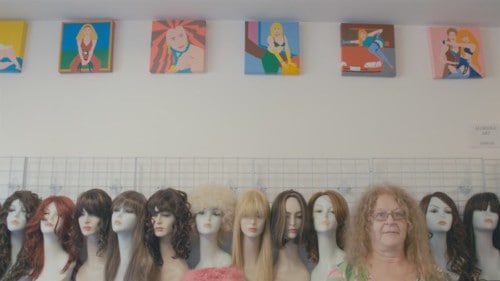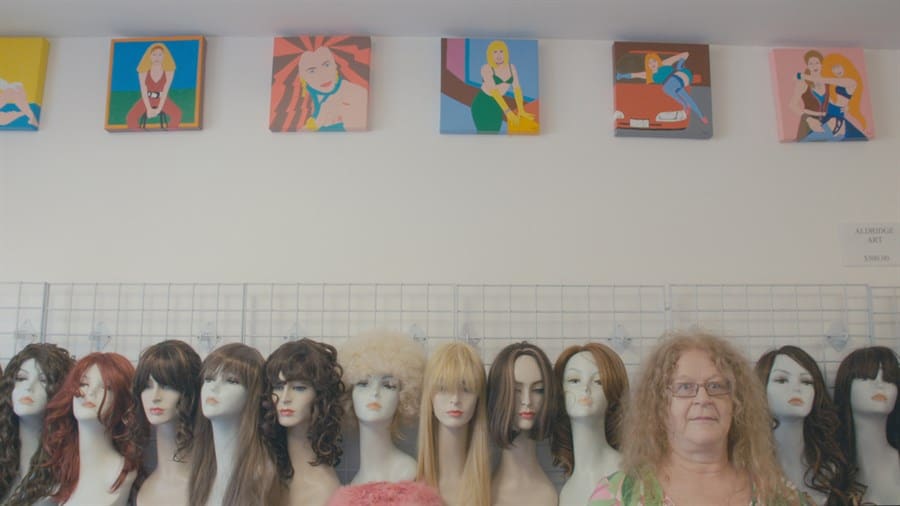In Take A Walk On The Wildside, director Lisa Rideout ventures into Toronto’s iconic cross-dressing store, Wildside. Owner Paddy Aldridge sells wigs, silicone breasts and stiletto heels to her customers – some of whom have been living out their dress-up fantasies for more than thirty years.
We chatted with Rideout this week.
SDTC: What initially drew you to this subject?
LR: I first visited Wildside in October of 2015. I was scouting the store as a location for a different film shoot. I was initially drawn to Wildside visually. As a director, the objects in the store were a dream for me: the life-like mannequins, the various styles of wigs, the corsets with silver spikes, the long fake lashes. Every inch of the store was covered in visually intriguing items that were colourful, over the top and had their own story to tell.
The store is directly in front of Allen Gardens. The first day I visited I remember thinking how strange it was that I did not know about the store. When I started to mention the store to other people, they had the same reaction as me, always saying, “I’ll look out for it next time.” Even though the store had been a pillar in the cross-dressing community for the last thirty years, it seemed many people outside of the community did not know about it. That really solidified my interest in pursuing the film and bringing the story of Wildside to a larger audience.

What about the owner’s story did you find compelling?
While the visuals in the store peaked my interest initially, it was the way that the storeowner Patricia Aldridge (Paddy) interacted with her clients that I found most compelling. After we chatted about making the film, I started to sit in at the store to observe Paddy. Paddy was warm, patient and generous with every customer that came through the door.
One of the main questions I had after my first visit was whether Wildside was relevant in the age of online shopping. When Wildside opened thirty years ago, options were limited in terms of purchasing cross-dressing items. Now there’s online shopping and YouTube tutorials for all things cross-dressing related. I wondered why people would still go to a store.
What became clear after spending time with Paddy and her customers was that shopping at Wildside was more than buying a pair of shoes or a wig. Paddy was someone that customers could trust. Someone they could talk to and disclose information about themselves that they had sometimes not told anyone else. This human connection element became the most pivotal part of the story for me.
How did you approach the style of the doc?
The style of the film materialized from the days I spent observing Paddy in the store. I wanted viewers to be able to see those genuine and important moments between Paddy and her customers. Based on this, I decided that the best approach stylistically would be an observational-fly on the wall documentary.
The film shows a day in the life of Wildside, from when Paddy opens the store to when she closes it. Four customers come through the store for a variety of reasons. Audiences learn a bit about the customers’ lives through their conversations with Paddy. I think this stylistic approach really showcased the heart of Wildside. I also wanted to reach an audience that would not typically watch a documentary about this topic.
Some of the documentaries that were inspirations were Rich Hill, Above and Below and the short documentary film Hotel 22. They are all beautiful films that tell important stories through a “fly on the wall” lens.

Director Lisa Rideout
What most surprised you about the cross-dressing community in Toronto?
During my first day at Wildside, a man in a collared shirt who worked in the financial district came into the store. He bought large breasts and a long blond wig. Paddy asked him if he was open to chatting with me about his experiences and he said no. Thirty minutes after leaving the store Paddy got a phone call. It was the same customer asking if I was still there and if I wanted to meet him for a drink. He changed his mind and thought it was an important story we were telling.
I walked up to the bar to find the customer dressed in the items he just bought. We sat in the back of the bar where no one would see us (at his request) and spoke for two hours. He told me about his wife and children that do not know. The shed at home where he hides his purchases. The workplace that would fire him if they found out.
This was a common experience I heard over and over again. That people could not tell anyone. I found that the most surprising. I went into creating this film a bit naively perhaps, thinking we have come so far in terms of acceptance, especially in Toronto. But I do not think that is completely true. And this lack of acceptance really highlighted the importance of places like Wildside for me.
What do you hope audiences take away from your film?
I hope that Take a Walk on the Wildside humanizes cross-dressers. Whenever I mention that I am working on this film, I get asked the question, “Why do people cross-dress.” And I always answer that it depends on the person. I think what can happen when a community of people are underrepresented in the media, it becomes much easier to stereotype them or see them as a mass of people rather than individuals.
I hope this films illustrates that cross-dressers are anyone. They are the person you work with, your husband, the friend you have known for years. And that they have varying reasons for doing it. I hope that being able to see cross-dressers as individual humans allows audience members to connect and empathize with them. And, that this connection encourages acceptance.
Take A Walk On The Wildside screens on April 29 & May 1 at Hot Docs. Get tickets here.



 Follow Us On Instagram
Follow Us On Instagram
